2019 LOOR Racing Guide
The official Lake Ontario Offshore Racing Guide. Get all your LOOR sponsored events plus much more. Tips on weather, safety and equipment. Great racing stories. Informative dates and tips.
The official Lake Ontario Offshore Racing Guide. Get all your LOOR sponsored events plus much more. Tips on weather, safety and equipment. Great racing stories. Informative dates and tips.
You also want an ePaper? Increase the reach of your titles
YUMPU automatically turns print PDFs into web optimized ePapers that Google loves.
Page 56 Lake Ontario Offshore <strong>Racing</strong> <strong>Guide</strong><br />
Preparing for the storm<br />
Preparations for the storm will vary depending on the type of boat you have,<br />
the equipment on board, the conditions and duration of the storm, your<br />
and the crew’s skills and experience, as well as your position in the water,<br />
whether near or off-shore. The following suggestions are based on storms<br />
that last around one to two hours.<br />
If the thunderstorm or squall is small, and you see it early enough on radar<br />
via your smartphone app, you may be able to estimate the storm’s speed<br />
and direction, giving you a chance to change course in time to escape.<br />
One of the most common ways to get ready ahead of severe weather is to<br />
drop or reef your sails well before the possibility of sudden high wind arises.<br />
It’s better to do this as early as possible - don’t wait until the boat is heeled<br />
over to make this decision. Once you have dropped the sails, start the boat’s<br />
engine and leave it in neutral so you are ready to go should you need to motor<br />
directly into the wind and waves during the worst of the storm. This will give<br />
you maximum control of the vessel. Sailing or, in this case, motoring, bow-on<br />
into the waves is your best defense in a high-wind situation. Make sure to<br />
avoid positioning your vessel beam-on to the waves.<br />
Another option is to heave-to. This is a way to stall the boat while pointing<br />
it at an angle into the wind and waves. Practice this maneuver on really<br />
windy days so that you get familiar with it and you know exactly how<br />
your boat will respond when placed in this position. Heaving-to is much<br />
safer than simply dropping the sails, locking the tiller to leeward and<br />
drifting, which is called lying ahull.<br />
Faced with an oncoming storm, you also have the option to reef your sails<br />
and prepare to run off. By doing this, you are running downwind and down<br />
the waves in a controlled manner.<br />
If you have enough time before the storm hits, look for a sheltered area to<br />
drop anchor. Secure the boat and hunker down until the severe weather passes.<br />
And, of course, don’t forget the basics. Make sure everyone onboard is<br />
wearing a personal floatation device (PFD). Any crew on deck should also be<br />
wearing a harness and tether. Turn on your navigation lights and take note<br />
of your current position. Tune your radio to the marine weather band and<br />
pay attention to any update on the approaching storm. Remember, as the<br />
captain, it’s your job to always be thinking ahead and preparing for all<br />
possible situations, including man overboard, a direct lightning strike, or<br />
the loss of all onboard electronics.<br />
Tools of the trade<br />
These days your smartphone is one of the most useful tools at your disposal.<br />
Apps specifically geared towards the mariner offer assistance and information<br />
on navigation, anchoring, safety, sail trim, weather forecasts and much more.<br />
These apps are powerful additions to your sailing kit.<br />
Thunderstorms and squalls generally show up quite vividly on radar, allowing


